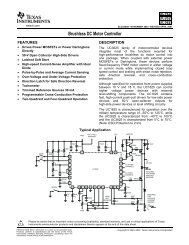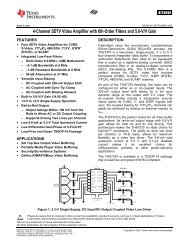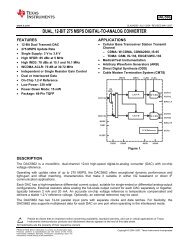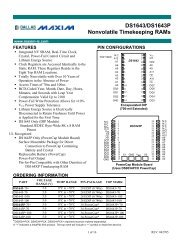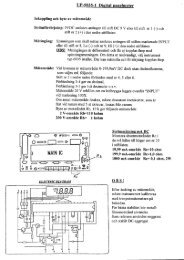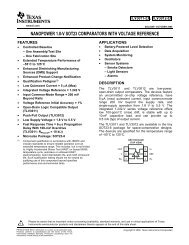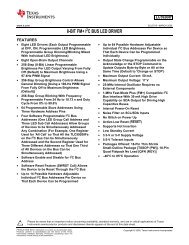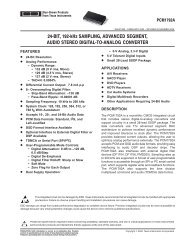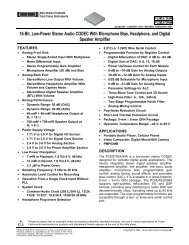Single-Chip Low Power RF Transceiver for Narrowband Systems ...
Single-Chip Low Power RF Transceiver for Narrowband Systems ...
Single-Chip Low Power RF Transceiver for Narrowband Systems ...
Create successful ePaper yourself
Turn your PDF publications into a flip-book with our unique Google optimized e-Paper software.
9.1. 4-wire Serial Configuration Interface<br />
CC1021 is configured via a simple 4-wire<br />
SPI-compatible interface (PDI, PDO,<br />
PCLK and PSEL) where CC1021 is the<br />
slave. There are 8-bit configuration<br />
registers, each addressed by a 7-bit<br />
address. A Read/Write bit initiates a read<br />
or write operation. A full configuration of<br />
CC1021 requires sending 33 data frames of<br />
16 bits each (7 address bits, R/W bit and 8<br />
data bits). The time needed <strong>for</strong> a full<br />
configuration depends on the PCLK<br />
frequency. With a PCLK frequency of 10<br />
MHz the full configuration is done in less<br />
than 53 µs. Setting the device in power<br />
down mode requires sending one frame<br />
only and will in this case take less than 2<br />
µs. All registers are also readable.<br />
During each write-cycle, 16 bits are sent<br />
on the PDI-line. The seven most<br />
significant bits of each data frame (A6:0)<br />
are the address-bits. A6 is the MSB (Most<br />
Significant Bit) of the address and is sent<br />
as the first bit. The next bit is the R/W bit<br />
(high <strong>for</strong> write, low <strong>for</strong> read). The 8 databits<br />
are then transferred (D7:0). During<br />
address and data transfer the PSEL<br />
(Program SELect) must be kept low. See<br />
Figure 7.<br />
The timing <strong>for</strong> the programming is also<br />
shown in Figure 7 with reference to Table<br />
PCLK<br />
PDI<br />
PDO<br />
PSEL<br />
T SS<br />
T CL,min<br />
T CH,min<br />
Address Write mode<br />
CC1021<br />
14. The clocking of the data on PDI is<br />
done on the positive edge of PCLK. Data<br />
should be set up on the negative edge of<br />
PCLK by the microcontroller. When the<br />
last bit, D0, of the 8 data-bits has been<br />
loaded, the data word is loaded into the<br />
internal configuration register.<br />
The configuration data will be retained<br />
during a programmed power down mode,<br />
but not when the power supply is turned<br />
off. The registers can be programmed in<br />
any order.<br />
The configuration registers can also be<br />
read by the microcontroller via the same<br />
configuration interface. The seven address<br />
bits are sent first, then the R/W bit set low<br />
to initiate the data read-back. CC1021 then<br />
returns the data from the addressed<br />
register. PDO is used as the data output<br />
and must be configured as an input by the<br />
microcontroller. The PDO is set at the<br />
negative edge of PCLK and should be<br />
sampled at the positive edge. The read<br />
operation is illustrated in Figure 8.<br />
PSEL must be set high between each<br />
read/write operation.<br />
T HD<br />
Data byte<br />
6 5 4 3 2 1 0 W 7 6 5 4 3 2 1 0<br />
Figure 7. Configuration registers write operation<br />
T SD<br />
T HS<br />
SWRS045B Page 23 of 89



